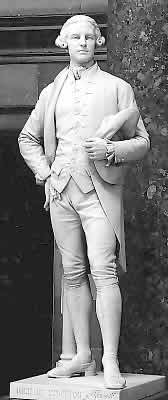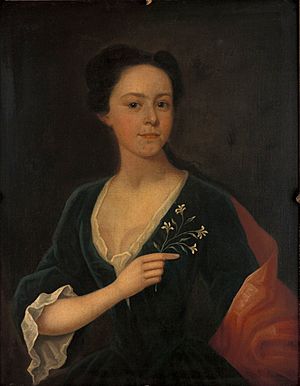Richard Stockton (Continental Congressman) facts for kids
Quick facts for kids
Richard Stockton
|
|
|---|---|

Richard Stockton, National Statuary Hall Collection statue
|
|
| Born | October 1, 1730 near Princeton, New Jersey, U.S.
|
| Died | February 28, 1781 (aged 50) Princeton, New Jersey, U.S.
|
| Resting place | Stony Brook Quaker Meeting House Burial Ground, Princeton |
| Known for | signer of the United States Declaration of Independence |
| Signature | |
 |
|
Richard Stockton (born October 1, 1730 – died February 28, 1781) was an important American leader. He was one of the Founding Fathers. He worked as a lawyer and a judge. He also helped make laws. Most importantly, he was one of the people who signed the Declaration of Independence.
Contents
Richard Stockton's Early Life
Richard Stockton was born in Princeton, New Jersey. His family home was called Morven. His father, John Stockton, was a rich landowner. John helped bring what is now Princeton University to Princeton. At that time, it was called the College of New Jersey.
Richard went to school at Samuel Finley's academy. He then went to the College of New Jersey. He graduated in 1748. After college, he studied law with David Ogden. David Ogden was a top lawyer in the area.
Stockton became a lawyer in 1754. He quickly became very successful. In 1763, he earned the highest law degree. He was a longtime friend of George Washington. Richard Stockton married Annis Boudinot Stockton. She was a poet and the sister of Elias Boudinot. Richard and Annis had six children. Their son, Richard Stockton, also became a famous lawyer.
Richard Stockton was not very interested in politics at first. He once wrote that public service was often thankless. However, he was very active as a trustee for the College of New Jersey.
Richard Stockton's Political Journey
Stockton served as a trustee for Princeton University for 26 years. In 1766 and 1767, he stopped practicing law. He traveled to England, Scotland, and Ireland. People there already knew about him. He met many important people.
Stockton even met King George III. He gave the King a message from the College of New Jersey. The message thanked the King for ending the Stamp Act. The King received him well. Stockton also talked about American issues with leaders like the Marquess of Rockingham. He met Edmund Burke and other members of Parliament. These leaders were friendly to the American colonies.
In Scotland, Stockton convinced Reverend John Witherspoon to become the president of the college. Witherspoon's wife did not want him to take the job. But with help from Benjamin Rush, her mind was changed. This was a very important moment for education in America.
Stockton returned to America in 1767. In 1768, he joined the New Jersey Provincial Council. This was his first government job. In 1774, he was appointed to the New Jersey Supreme Court. He also joined the American Philosophical Society.
At first, Stockton tried to find a peaceful solution between the colonies and Britain. In 1774, he suggested a plan for America to govern itself. This plan would keep America connected to the British Crown. But the King did not accept it.
Richard Stockton and the Revolutionary War
In 1776, Stockton was chosen to join the Second Continental Congress. He played a very active role there. That August, he was almost elected governor of New Jersey. He tied with William Livingston on the first vote. Livingston won by one vote later. Stockton was then chosen to be the chief justice of the New Jersey Supreme Court. But he turned down the job to stay in Congress. Richard Stockton was the first person from New Jersey to sign the Declaration of Independence.
Congress sent Stockton and George Clymer on a long trip. They went to Fort Ticonderoga in New York. Their job was to help the Continental Army during the American Revolutionary War. On his way back, Stockton went to a friend's house. He wanted to help his family move to safety.
On November 30, 1776, Stockton was captured by Loyalists. He was taken from his bed in the middle of the night. His property was stolen. He was marched to Perth Amboy and given to the British. The British treated him very harshly. He was put in chains and treated like a criminal.
Stockton was moved to Provost Prison in New York. He was intentionally starved and kept in freezing cold. After almost five weeks of terrible treatment, he was released. His health was ruined. His home, Morven, was taken over by General Charles Cornwallis. The British stole his library and furniture.
Stockton's harsh treatment in prison made the Continental Congress act. They asked General George Washington to look into it. Stockton was released on parole on January 13, 1777. This meant he promised not to get involved in the war.
Dr. Benjamin Rush wrote about Stockton's release. He said Stockton's home was plundered. Stockton had to sign a paper to be released. This paper was a promise not to interfere in American affairs during the war. Because of this promise, Stockton resigned from Congress. It took him almost two years to get his health back.
Some rumors spread that Stockton had accepted protection from the British. But Reverend John Witherspoon said these rumors were doubtful. He noted that a distant cousin, Major Richard Stockton, was a Tory. This cousin had joined the British. People might have confused the two.
Richard Stockton's Final Years and Legacy
No one ever wrote about doubts of Stockton's loyalty in official papers or newspapers. When his health allowed, Stockton tried to work again. He reopened his law practice and taught students. Two years after leaving prison, he developed cancer of the lip. The cancer spread to his throat. He was in pain until he died on February 28, 1781, at Morven.
His funeral was held at Nassau Hall. Many people, friends, and students attended. Reverend Doctor Samuel Stanhope Smith gave the eulogy. He spoke of Stockton's wisdom and service to his country. Smith said Stockton had served as a judge with great honesty and knowledge. He also represented New Jersey in Congress. But his health had declined, and he had to retire from public duty.
On March 7, 1781, The New Jersey Gazette praised Stockton. It said he performed his duties with great skill, dignity, and honesty. His family had been Quakers for two generations. He wished to be buried at the Stony Brook Meeting House Cemetery in Princeton.
Stockton and his wife, Annis, were close friends with General Washington. After Stockton's death, Annis became a favorite person for Washington to write letters to. Washington and his wife Martha often visited Morven.
In 1888, New Jersey gave a marble statue of Stockton to the National Statuary Hall Collection in the United States Capitol. He is one of only six signers to be honored this way. In 1969, New Jersey started a state college named after Stockton. It is now called Stockton University. A rest area on the southbound New Jersey Turnpike is also named after him.
Richard Stockton's Family
Richard Stockton and his wife had six children. They had four daughters and two sons: Julia, Mary, Susan, Richard, Lucius, and Abigail. Julia married Benjamin Rush, who also signed the Declaration of Independence.
Stockton's oldest son, Richard, became a lawyer and a U.S. Senator for New Jersey. His grandson, Commodore Robert Field Stockton, was a hero in the War of 1812. In 1846, he became the military governor of California. He also served as a Senator from New Jersey.
See also
Images for kids



